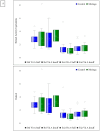Impact of Maternal Moringa oleifera Leaf Supplementation on Milk and Serum Vitamin A and Carotenoid Concentrations in a Cohort of Breastfeeding Kenyan Women and Their Infants
- PMID: 39408390
- PMCID: PMC11478761
- DOI: 10.3390/nu16193425
Impact of Maternal Moringa oleifera Leaf Supplementation on Milk and Serum Vitamin A and Carotenoid Concentrations in a Cohort of Breastfeeding Kenyan Women and Their Infants
Abstract
Background: Childhood vitamin A deficiency leads to increased morbidity and mortality. Human milk is the only source of vitamin A for exclusively breastfed infants. Dried Moringa oleifera leaf powder (moringa) is a good food source of provitamin A and other carotenoids. Its effect during lactation on human milk vitamin A and carotenoid content is unclear. Objectives: Our objective was to investigate the effect of maternal moringa consumption on human milk retinol and carotenoid concentrations and maternal and infant vitamin A status. Methods: We conducted a 3-month pilot single-blinded cluster-randomized controlled trial in breastfeeding mother-infant pairs (n = 50) in Kenya. Mothers received corn porridge with (20 g/d) or without moringa with complete breast expressions and maternal and infant serum collected at enrollment (infant <30 days old) and 3 months. Milk was analyzed for retinol and selected carotenoids; maternal/infant serum was analyzed for retinol binding protein (RBP). Results: 88% (n = 44) pairs completed milk and serum samples. Four mothers (9%) had vitamin A deficiency (RBP <0.07 µmol/L); 11 (25%) were vitamin A insufficient (VAI; RBP <1.05 µmol/L). Alpha-carotene concentration in milk was higher in the moringa than the control group at baseline (p = 0.024) and at exit (least squares means, LSM, 95%CI µg/mL 0.003, 0.003-0.004 moringa vs. 0.002, 0.001-0.003 control, n = 22/cluster; p = 0.014). In mothers with VAI, alpha-carotene was higher in the moringa group than controls at exit (LSM, 95%CI µg/mL 0.005, 0.003-0.009 moringa, n = 3, vs. 0.002, 0.000-0.004 control, n = 8, p = 0.027) with no difference at baseline. Milk carotenoids did not correlate with vitamin A status (serum RBP) in infants or mothers. Conclusions: Maternal moringa consumption did not impact concentration of milk vitamin A and resulted in limited increase in milk carotenoids in this cohort.
Keywords: carotenoids; human milk; maternal and child health; vitamin A.
Conflict of interest statement
The authors declare no conflicts of interest.
Figures







References
-
- Stevens G.A., Bennett J.E., Hennocq Q., Lu Y., De-Regil L.M., Rogers L., Danaei G., Li G., White R.A., Flaxman S.R., et al. Trends and mortality effects of vitamin A deficiency in children in 138 low-income and middle-income countries between 1991 and 2013: A pooled analysis of population-based surveys. Lancet Glob. Health. 2015;3:e528–e536. doi: 10.1016/S2214-109X(15)00039-X. - DOI - PubMed
-
- Oyunga M.A., Grant F.K.E., Omondi D.O., Ouedraogo H., Levin C., Low J.W. Prevalence and predictors of vitamin A deficiency among infants in western Kenya using a cross-sectional analysis. Afr. J. Food Agric. Nutr. Dev. 2016;16:10765–10786. doi: 10.18697/ajfand.73.16190. - DOI
-
- Ngare D.K., Muttunga J.N., Njonge E. Vitamin A deficiency in pre-school children in Kenya. East. Afr. Med. J. 2000;77:421–424. - PubMed
-
- Imdad A., Rehman F., Davis E., Attia S., Ranjit D., Surin G.S., Lawler S., Smith A., Bhutta Z.A. Effect of Synthetic Vitamin A and Probiotics Supplementation for Prevention of Morbidity and Mortality during the Neonatal Period. A Systematic Review and Meta-Analysis of Studies from Low- and Middle-Income Countries. Nutrients. 2020;12:791. doi: 10.3390/nu12030791. - DOI - PMC - PubMed
-
- Mayo-Wilson E., Imdad A., Herzer K., Yakoob M.Y., Bhutta Z.A. Vitamin A supplements for preventing mortality, illness, and blindness in children aged under 5: Systematic review and meta-analysis. [(accessed on 22 March 2018)];BMJ. 2011 343:d5094. doi: 10.1136/bmj.d5094. Available online: http://www.ncbi.nlm.nih.gov/pubmed/21868478. - DOI - PMC - PubMed
Publication types
MeSH terms
Substances
Grants and funding
- NIH BIRCWH K12DA035150, University of Kentucky Department of Pediatrics to Dr. Attia, and NIH 1K01TW009987-01 award to Dr. Waterman. The use of REDCap University of Kentucky was supported by the University of Kentucky NIH CTSA UL1TR001998. The supporting/NIH BIRCWH K12DA035150, University of Kentucky Department of Pediatrics to Dr. Attia, and NIH 1K01TW009987-01 award to Dr. Waterman. The use of REDCap University of Kentucky was supported by the University of Kentucky NIH CTSA UL1TR001998. The supporting
- NIH BIRCWH K12DA035150, University of Kentucky Department of Pediatrics to Dr. Attia, and NIH 1K01TW009987-01 award to Dr. Waterman. The use of REDCap University of Kentucky was supported by the University of Kentucky NIH CTSA UL1TR001998. The supporting/NIH BIRCWH K12DA035150, University of Kentucky Department of Pediatrics to Dr. Attia, and NIH 1K01TW009987-01 award to Dr. Waterman. The use of REDCap University of Kentucky was supported by the University of Kentucky NIH CTSA UL1TR001998. The supporting

